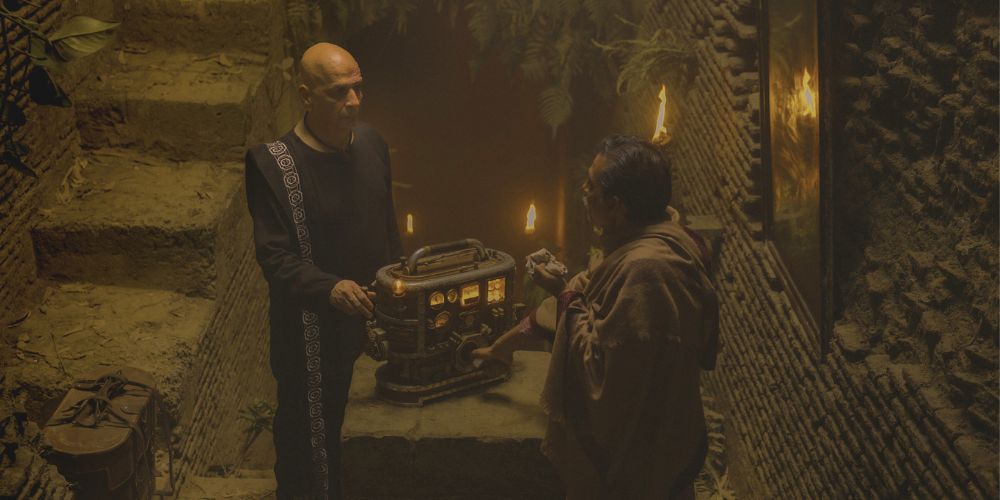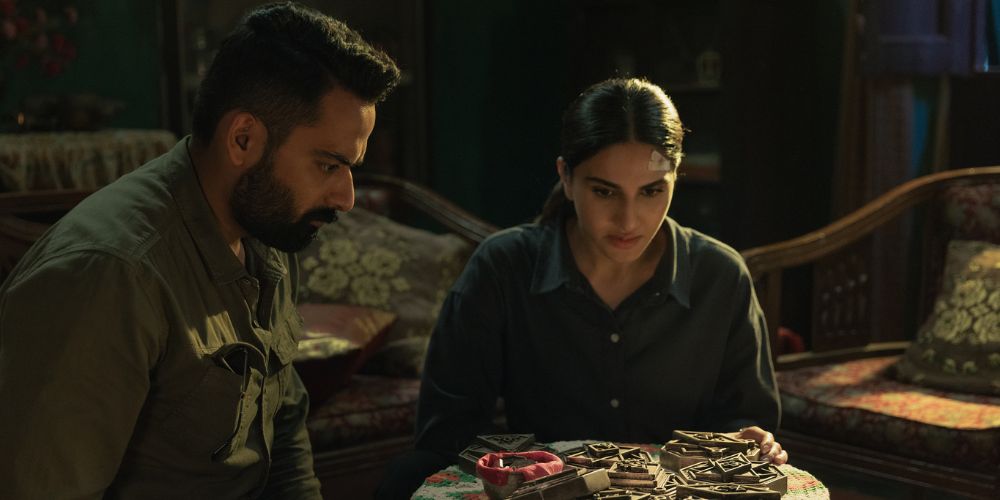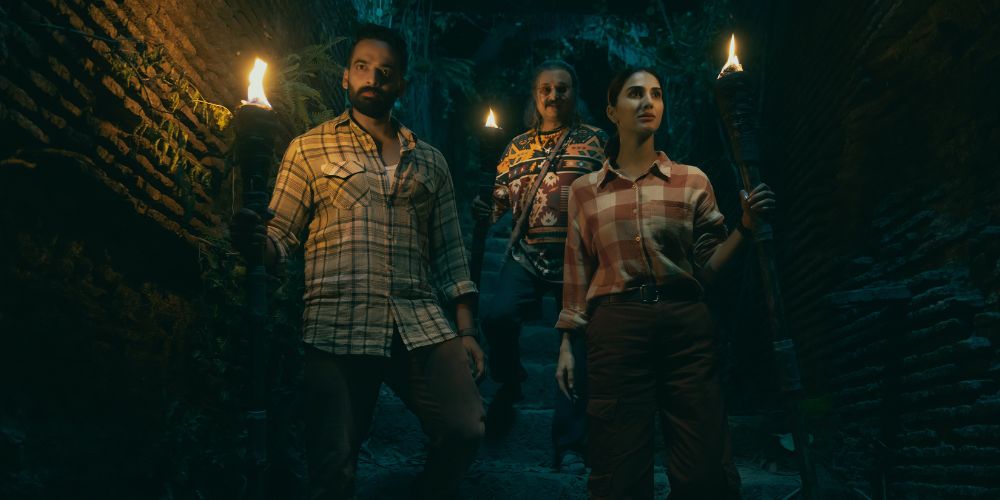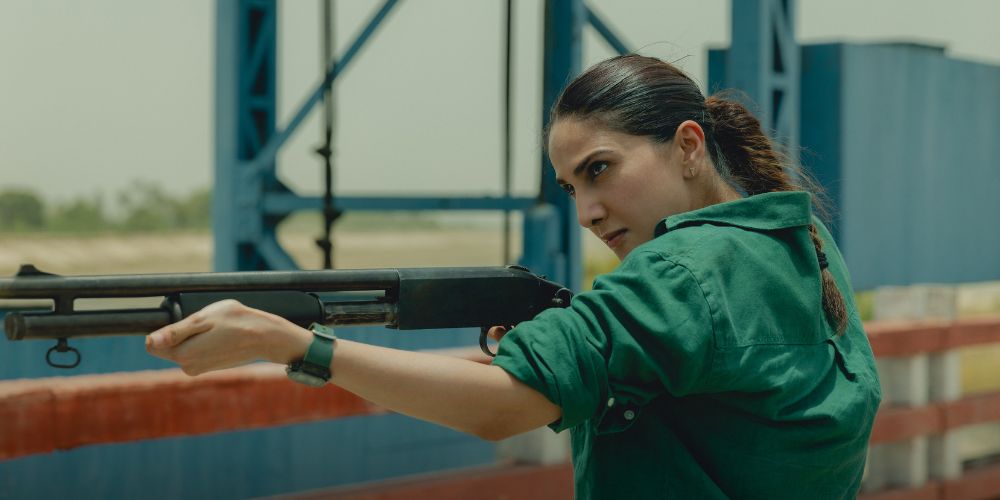‘Mandala Murders‘ is a Hindi-language crime thriller series that tells the story of the gruesome murders taking place in the town of Charandaspur. Two brave police officers, Rea Thomas and Vikram Singh, have taken responsibility for solving the case and stopping the killer who has been terrorizing the city. As they dig deeper into the case, they realize that the murders taking place are actually ritualistic killings and a secret society, Aayast Mandal, might be responsible for it. The involvement of this secret society and their Aayast Yantra takes the investigators on a path filled with grave danger as they come face-to-face with shocking truths about the case and their own lives.
Moreover, they realize that these killings are not random acts of violence but part of something rooted in the dark history of the town, which involves a reincarnation plot for the God, Yast. Even though the story primarily focuses on murders, it explores a lot about the secret society and the way in which people conduct themselves. The narrative is not just about the murders, but also about clashing ideologies. The inclusion of these aspects not only adds depth to the story, but it also creates curiosity about whether it takes inspiration from a real-life secret society and its ways of living.
Aayast Yantra is a Fictional Device Used to Harness Universal Energy
In ‘Mandala Murders,’ central characters such as Rea Thomas, Vikram Singh, and Ananya Bharadwaj find themselves in the middle of a murder mystery. While Rea and Vikram are trying to solve the murders, Ananya is taking advantage of these killings to take her political career to new heights. Soon, they get to know that these murders are ritualistic killings, and apart from slaying people, the killer is taking their body parts with them. As the story progresses, the investigators learn about Aayast Mandal, their ways of living, and a device called Aayast Yantra. All the chaos happening in Charandaspur is because of this device and how Aayastis have been using it to move a step closer to bringing their deity, Yast, back to earth. Although the story is based on the 2014 novel ‘The Butcher of Benares,’ the plot remains fictional, meaning that there’s no real-life device such as Aayast Yantra.

Initially, Aayast Yantra is shown as a device that can grant a wish if a person sacrifices their right thumb. Additionally, people should have a special coin, which has the symbol of Aayast Mandal on it, to get their wish. However, the real purpose of this machine is revealed at the very end and is far more sinister than just the sacrifice of a thumb. Aayast Yantra is a fictional device that can harness universal energy in the sense of creating something from nothing. In reality, there is no such machine that can perform the aforementioned task. The fundamentals of Physics state that “energy cannot be created or destroyed,” and if a machine tries to do that, it could cause chaos. Throughout history, there has been no such machine. Consequently, Aayast Yantra is a pivotal plot point that comes from the minds of the show’s creators. However, in the story, Rukmini wants to control the universal energy and bring her God, Yast, back to earth.
But how does such a machine fall into the hands of the Aayastis? In 1951, Nandini, Rea’s grandmother and a particle physicist, is working on a device similar to this when she comes in contact with Aayastis. Nandini and her husband, Anant, are there to let them know that the government will be building a nuclear plant in and around Varuna Forest. As a result, they would have to demolish their Aayasthal. While they demolish the structure, Nandini returns to their guest house while Anant oversees the destruction of Aayasthal. A few moments later, Rukmini meets Nandini and tells her about the Aayast Grant. She claims that the woman who will be responsible for the destruction of the Aayasthal would also help the Aayastis in the creation of their God, Yast. That woman will have three characteristics, and one of them is that she will be working on an energy device.

Nandini, being a particle physicist, keeps on working on such projects, and there’s a glimpse of a machine like Aayast Yantra that she has been working on. The other two characteristics are that the woman will be pregnant and a widow. Soon, Nandini learns about Anant’s death in an accident. At the time, she is pregnant with Anant’s child. After learning about the prophecy, she starts making a machine for the Aayast Mandal, and even though she knows that they will use the machine to create Yast, she believes that it would be a massive moment in the history of mankind if they really could bring the God back into a mortal vessel. Thus, making Aayast Yantra a pivotal aspect of the narrative. However, it is fictional, just like the story it inhabits.
Aayast Mandal Is a Made-Up Secret Society Inspired by Cult Groups
Similar to the overarching narrative in ‘Mandala Murders,’ Aayast Mandal is also a work of fiction without any real evidence that a secret society like that existed. Most of the members of Aayast Mandal are women, and throughout the series, it is shown that only one male person is a part of this society. People of the Mandal live by their own ways and have different ideologies. They believe that the world doesn’t consider them as part of society, and they have faced years of injustice. To make the world know about their presence, they need to create a perfect human body so that they can use the Aayast Yantra to bring their deity, Yast, back into the world. The physicality of this perfect body comes from Leonardo Da Vinci’s famous painting, The Vitruvian Man.

The Vitruvian Man depicts the perfect ratios and proportions in human anatomy. In simpler words, the Vitruvian Man showcases the anatomy of a perfect human being. As a result, the mandal believes they require different body parts to create a perfect vessel for Yast because, for them, Yast is the epitome of greatness and requires a perfect body to live in. Moreover, the Mandal doesn’t shy away from killing people to accomplish their mission, which makes it less like a normal community and more like a cult. In real life, several groups and their members have been operating on similar lines. In the 1980s, Ron Lafferty, a member of the polygamist cult called the School of Prophets, killed his brother’s wife and her kid for refusing the idea of plural marriage. When the police arrested him for the murders, he revealed that he had murdered her following what he believed to be a divine message. Lafferty went to trial for the murders and was found guilty by the jury, which sentenced him to death.
Meanwhile, in 1974, Marshall Applewhite and Bonnie Nettles created a religious group named Heaven’s Gate after having certain visions. They told their followers that angels in the Bible are extraterrestrial beings superior to humans, and in the final days of the world, they’ll come to destroy the earth and save only those who are faithful. But when Nettles died in 1985 because of cancer, the followers of Heaven’s Gate, including Applewhite, consumed a dangerous chemical that killed them. This seems eerily similar to Aayast Manda and its leader, Rukmini. The way Rukmini is convinced that Yast will restore balance in the world makes it feel like she has received a message from their God. Also, Nettles and Applewhite believed that these angels would only save the faithful. Rukmini also states that people who worship Yast are going to be the only ones living in the new world. Even though Rukmini has no direct relation to the people mentioned above, her thought process remains the core ideal of the on-screen cult, Aayast Mandal.
Is Yast Based on a Real Deity?
It’s evident that ‘Mandala Murders’ uses fictional components to take the story forward. Even though it is based on Mahendra Jakhar’s novel ‘The Butcher of Benares,’ all the plot points in the series have no resemblance to real-life events. Whether it is the Aayast Mandal or the Aayast Yantra, every narrative is used as a purely fictional ploy. However, one of the most important storylines in the series is the resurrection of their God, Yast, and his ability to bring peace to their lives. But just like any other plot device, Yast is also fictional. Thus, the character is not based on a real deity. Although the name is pretty similar to Yasht in Zoroastrianism, they are not related, and in reality, Yasht has a completely different meaning. Rather than a deity, Yasht is a collection of 21 hymns in Zoroastrianism that are dedicated to a special divinity. As a result, Yast and Yasht have no similarities.

In the show, Yast is a fictional god or a concept that the Aayastis believe in. The group or cult believes that they can achieve a better and more peaceful life if they are able to assemble a perfect human form from the body parts of their victims. The idea of how to create a perfect human body is described in their symbols. Every symbol refers to a body part needed for the perfect human being, and those are: the head of a teacher, the hands of sinners, the feet of the servant’s child, the face of a princess, the torso of a voyeur, and the blood of a miracle child. When they have found every single one of the aforementioned body parts, they will be able to create a perfect vessel for Yast. Although they try to make the god’s physical form on a couple of occasions, the Aayast Mandal fails to bring him to earth.
This aspect of the series seems to possess a parallel to how Victor Frankenstein created the monster in Mary Shelley’s 1818 novel ‘Frankenstein’. In the novel, Victor creates the monster over a period of two years in his attic after discovering a scientific technique to create life from non-living matter. The only difference is that Victor doesn’t engage in mass murder like the Aayastis do. Consequently, there’s no reason to believe that what Rukmini said is true. No one has ever seen a glimpse of Yast or what God looks like. It could have been just Rukmini manipulating everyone to become a cult-like figure. Nevertheless, the overarching narrative of Yast being a god is solely based on fiction, and the character is not based on a real deity.


